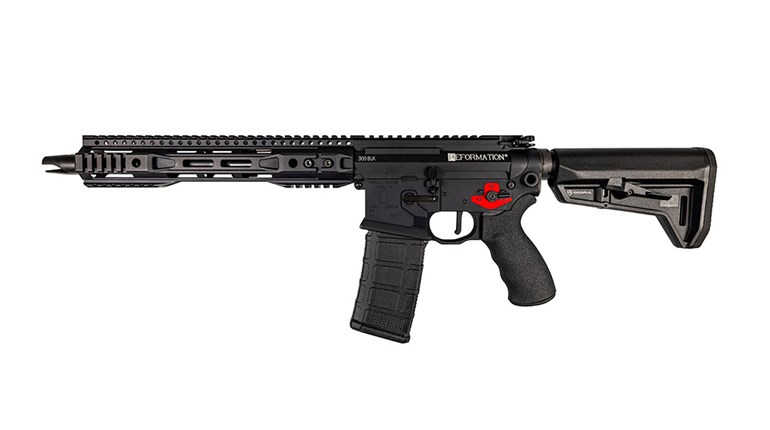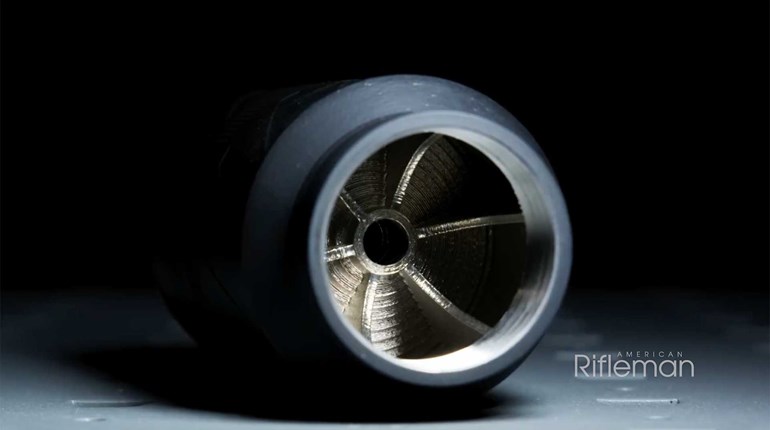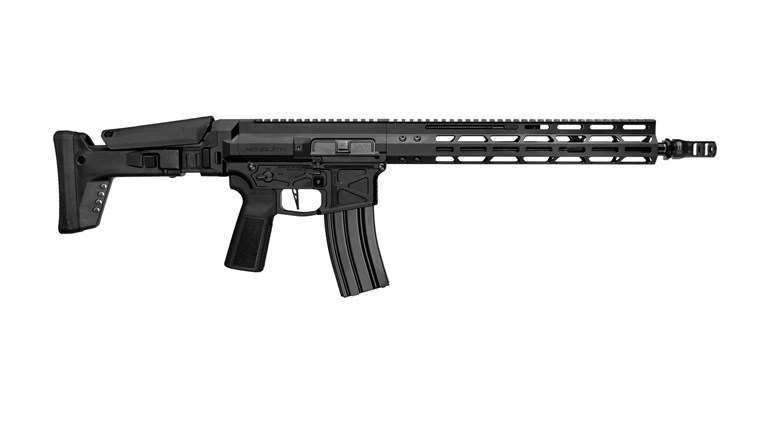
When designing a new firearm, one can think inside the box or out of it. Eugene Stoner and the Costa Mesa ArmaLite team were thinking outside the box when they designed the AR platform and the longest-serving rifle in U.S. history: the 5.56 NATO Colt M16. However, through the years nearly all attempts to create a viable Squad Automatic Weapon (SAW) from that 7-pound rifle have proved mediocre at best, with most never going beyond prototype or proving to be total failures—until now.

In 1998, a young small-arms student and designer named Geoffrey Herring conceived a completely new approach for converting the M16 into both a successful and viable squad-support weapon. While Herring was diligently refining his belt-fed conversion for the M16, the U.S. military was simultaneously revealing its interest in a "family of weapons" in public programs that included SOCOM's SOPMOD II and SCAR, the Army's OICW and the Marine Corps' IAR.
Heavily influenced by both the successes and failures of previous weapon designs—including the legendary Stoner 63/63A—and simultaneously realizing the value of a true family of weapons, Herring set out to develop the ultimate military small-arms system. Manufactured by Herring's company, ARES Defense Systems of Melbourne, FL, and named the Shrike 5.56 Advanced Weapons System, it is a radical departure from all previous designs.
Unlike the early ArmaLite and Colt attempts, Herring's design totally eliminates the entire M16 upper receiver, leaving the stock lower-receiver group to host the new mechanism. Retaining the unaltered, standard M16 lower-receiver group in the design allowed the serial number to remain intact and, just as important, kept the familiar fire controls in the event of an upgrade program. The patented Shrike 5.56 is supplied as a complete firearm or as an upper-receiver upgrade kit, which is compatible with any M16, M4 or mil-spec AR-15 lower receiver.

Operated by a short-stroke impinging gas piston for reliability in adverse conditions and waterborne operations, Shrike's patented side-mounted piston permits the weapon to use an improved top-mounted version of the original quick-change barrel system found in the Stoner 63/63A. Unlike the Stoner 63/63A, however, the Shrike allows total modularity between configurations without having to invert its receiver.
While the Shrike normally fires from a closed, multi-lugged bolt, it's also available with an open-bolt module that replaces the standard closed-bolt, fire-control components. Several lengths and weights of barrels are available, along with a rigid MIL-STD 1913 handguard, the front of which houses a precise-fitting bulkhead to support the front of the quick-change barrel—similar to the barrel extension of the .50-caliber M2HB machine gun. The adjustable front sight is mounted to the barrel's gas block.
On the left side of the upper receiver is the non-reciprocating charging handle, which can be folded when not in use. For clearance and access when used in the belt-fed mode, the handle is placed just to the rear of the belt-feed tray. For those who might worry about the left-hand orientation of the charging handle, consider many successful firearms, such as the Browning BAR, FN-FAL, Ultimax 100 and HK roller-locked designs, are charged with the left hand.
Three Feed Systems
The Shrike 5.56 family is broken down into three primary groups of weapons, which are either magazine-fed, belt-fed or dual-fed. The dual-fed version is capable of instantly going between belt or magazine feed at operator discretion. In the magazine-fed group are the Advanced Rifle (AR), Advanced Carbine (AC), Advanced Automatic Rifle (AAR), Advanced Automatic Rifle, Compact (AAR/C) and Designated Marksman Rifle (DMR). Kits in .22 LR and 9 mm are in development, both to be offered to qualifying entities with integrally suppressed barrel assemblies.

The belt-fed group includes the Shrike 5.56 Special Purpose Weapon (SPW) configuration. Featuring a unique and patented M16-type receiver, the SPW replaces the magazine well with a load-bearing dovetail mount close to the upper receiver. This reduces the overall height of the firearm by more than 2.5 inches for operating from the ground and also provides a perfect interface for vehicle window or boat gunwale mounts.
Finally there is Herring's pièce de résistance, the dual-feed Shrike 5.56 Assault Machine Gun (AMG). This super-lightweight configuration can be selectively fed from either an M16 magazine or a belt of linked SAW ammunition in true "plug-and-play" fashion without any weapon disassembly or reconfiguration. This capability is something that Cadillac Gage failed to accomplish in the Stoner 63/63A offering and may even be part of the reason for this historic weapon's relatively short life.
The primary difference between the magazine-fed versions and the dual-feed AMG is the firearm's top cover. The former examples close off the upper receiver and provide a mounting point for optics, while the AMG internally houses a belt-feed mechanism and is used in conjunction with a belt-feed tray. Switching the AMG from one feeding system to another takes 10 seconds and can be accomplished without any tools other than a single cartridge.
Behind the AMG's quick-change barrel lock is the top cover, which houses a two-step shuttle belt-feed system similar to that used on virtually all free-world light machine guns (LMGs). This conventional top cover allows the AMG to feed from a belt or from a 100-round bag mounted on the left side. Alternatively, the AMG is designed to accommodate any standard M249 SAW ammunition container such as the 100-round soft pouch or 200-round polymer box via a special dovetail adapter inserted into the rifle's empty magazine well.

Additionally, the Shrike AMG retains the ability to feed from any M16 magazine inserted into the standard magazine well, permitting an operator to selectively alternate between a box magazine or a belt of M27-linked 5.56 NATO ammunition.
The Shrike's top cover features a MIL-STD 1913 rail for mounting optics and night-vision devices, and it also accepts a protected, dual-aperture rear sight. It is unlocked to open using a spring-loaded button on the left rear side, similar to the Stoner 63/63A series, for easy belt loading.
Familiar Yet Unique
Since the Shrike uses the ARES-15 or ARES-16 (semi-auto or select-fire, respectively) lower-receiver groups or any mil-spec M16 or AR-15 lower-receiver group, the operational controls are identical to those which have been found on America's Rifle for more than 45 years. Initial takedown is also the same, but disassembly of the Shrike's upper receiver group differs slightly from the standard procedure used with the M16 and AR-15.
While the Shrike 5.56's firing pin, its retainer and a few other small upper-receiver parts are interchangeable with those of the AR-15/M16/M4, that's where the commonality ends. The Shrike's bolt, although resembling that of the M16, is radically different. More akin to the bolt of the AR-18, HK G36 or FN SCAR, the Shrike version remains a major departure even from these designs.
Because it was designed as a dual-purpose, sustained-fire bolt to work simultaneously with a top-mounted belt feed and a bottom-inserted box magazine, it has six instead of seven locking lugs. This allows the top lug to be positioned at 12 o'clock for feeding from the belt and the bottom two lugs to ride at 5 and 7 o'clock to reliably feed from a box magazine. The Shrike's bolt also rotates counterclockwise to open, with a longer dwell time, resulting in a slower, more gentle primary extraction. This, along with an intentionally delayed rotation of the bolt, prevents extraction failures.

Not only are the Shrike's bolt and barrel extension made of ultra-modern, high-strength materials with a special heat-treatment process, these parts also have tangentially radiused locking lugs that are heavier than standard M16 bolt and barrel-extension lugs. Because the radius design does not invite stress failures, the strength of the ARES locking system is significantly greater than that of the M16. If you're beginning to think this weapon was designed for high performance, you're right.
All versions of the Shrike 5.56 feature a quick-change barrel system, which is faster than any other such design for the AR platform. The system uses a spring-loaded, vertical, tapered pin that enters through the top of the barrel extension to center and anchor the barrel in position. The arrangement serves a second purpose as well: If there were a catastrophic case failure due to faulty ammunition or a bore obstruction, gas escaping into the barrel extension would take the easy way out through the receiver.
To remove a Shrike barrel, simply lock the bolt group to the rear where it's out of battery, depress the barrel-release lever in front of the receiver top cover and pull the barrel out the front of the handguard. To replace the barrel, depress and hold the lever while inserting the barrel as far as it will go before releasing. The precise-fitting locking pin securely snaps into place in the barrel extension.
Although ARES has tested a variety of barrel lengths, standard barrels are 12.5, 16.25 and 20 inches long, with the DMR variation using a special version of the latter. Designed for use in both precision and sustained-fire roles, all barrels are relatively heavy, but 12.5- and 16-inch lightweight assault barrels similar in contour to those of the original M16 are also available. ARES also offers fluted barrels and one with an integral sound suppressor for special military and law enforcement duties. Barrelsfeature either self-regulating or adjustable gas regulators. All are sound-suppressor capable and are completely interchangeable with any Shrike configuration.
Multiple Roles
While the Shrike 5.56 was originally envisioned as a device to convert any M16 or M4 variant into a belt-fed LMG, Herring quickly realized during tactics and endurance testing it would also nicely bridge the significant capability gap that exists between the M4A1 carbine and the M249 SAW. However, to anyone with even the slightest amount of trigger time on both weapons, it is instantly obvious the Shrike is capable of going far beyond that goal. For example, in comparing the Shrike AMG with a 12.5-inch barrel to the M249 Para, the Shrike—with an M203 40 mm grenade launcher, SureFire Mini suppressor and a loaded 100-round belt bag—still weighs 1 pound less than the 17-pound M249 Para all by itself, unloaded!
A dual-feed Shrike AMG with a Grip Pod weighs just 8.4 pounds. That means a Soldier or Marine could carry into combat an 11-pound, belt-fed weapon equipped with a loaded 100-round belt bag, and yet be able to instantly transition to magazine feed. Equipped with a 14.5- or 16-inch barrel and suppressor, an M203 grenade launcher and a tactical light/laser, the Shrike becomes what may prove to be the ideal infantry rifle, and with a 12.5-inch barrel, it's the perfect CQB weapon.
With the 20-inch, heavy DMR barrel and an optic, the Shrike becomes a selective-fire sniper rifle. With the DMR barrel, the system is capable of .5-MOA accuracy when firing match-grade 5.56 NATO ammunition. Magpul's Precision Rifle/Sniper buttstock is ARES' choice as standard equipment for the Shrike sniper LMG. Using this setup equipped with a Leupold Mark AR 1.5-4x20 mm scope, I was able to achieve 0.56-inch accuracy at 100 yards with the very first DMR barrel made by ARES.

Let's consider a possible military scenario: A sniper is set up with the Shrike in the DMR mode in a target-rich environment, having to reload only after the 100- or 200-round belt is exhausted using precision semi-automatic fire. Suddenly the enemy appears on a flank side at 100 yards. The operator has only to switch to full-automatic fire to engage and neutralize the closer threat.
In another scenario, an operator can stow his DMR barrel and optical sight in his pack, and carry his Shrike with a short barrel for defense while en route to his hide. He can then quickly switch to the prezeroed DMR barrel and optic for long-range shooting. If he has a sniper observer with him, he could start the mission in the DMR configuration, and the observer could be armed with a standard Shrike. Both operators could engage targets from point-blank range out to 600 meters and beyond.
Mission Ready
Having been invited to a fairly extensive 1,500-round test with two early versions of the Shrike 5.56 at the 2005 SHOT Show, and having put hundreds of rounds through the AAR and DMR magazine-fed rifles in early 2010 with no malfunctions, I had no doubts as to the viability of the system. However, my eyes were really opened when I was invited to ARES' brand-new facility in late 2010. While there, I was treated to a tour and a torture test of the latest versions of the Shrike 5.56 family, which are now in full production on ARES' high-end Mazak CNC machinery.
"It's been a long, winding road," said Herring, "but we're finally there." I won't bore you with the details of that journey, but I watched ARES' machines turning out virtually every part of the Shrike 5.56, and saw hundreds of finished receivers and components on racks in the assembly section. "You won't see racks of finished guns sitting here," noted Herring, "because after each Shrike upper-receiver group is finished and test fired, it is shipped out to a waiting customer."
While I was there, an inquiry came from a major Florida law enforcement agency regarding putting two Shrike AMGs on pedestal mounts for agency interdiction fast-boats. These boats must seek out, stop and board watercraft of many sizes. Two AMGs could cover most threats, and ARES' height-adjustable, shock-absorbing pedestal mounts would also support the operators while speeding through the water. The pair of Shrikes could also be removed and used to board suspect watercraft. Other large agencies will no doubt take note of the unique features offered by the Shrike 5.56 Advanced Weapons System. It's truly one weapon for any mission.






































